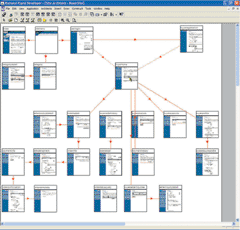IBM's RRD Insulates J2EE Complexity
RRD elegantly balances software architecture and development, and by wrapping J2EE into a visual environment, it allows programmers of all sorts to work together. RRD also supports IBM Portal Server development, which helps programmers tie code into enterprise portals.
Solution providers aren't always in control of how a team is assembled, so leveraging a range of programmers including those with legacy COBOL expertise and those with PL1 know-how can pose a challenge.

\
MARIO MOREJON
\
Technical Editor
With RRD, IBM has created an environment that insulates a great deal of the J2EE complexity from programmers. A key benefit to solution providers is that they can better compete on fixed-price contracts by reducing their labor-related costs.
Where RRD truly excels is in allowing non-J2EE programmers at all skill levels to work together, and with minimal knowledge of Java.
That's not to say that J2EE experts are not required, for project leaders often use a top-down development technique to build software. That means those leaders must be J2EE experts just to decide how a business design will be built.
RRD uses the Rational Unified Process and the Rational distributed development platform that includes team development and change management.
Typically, an initial RRD process calls for analysts to first gather business requirements and build a functional design based on the analysis of the business patterns found in the requirements. The project leader or technology architect then handles the business-level UML modeling using Rational Rose. RRD provides synchronization between the Rational Rose and RRD models such as class models and database schemas.
If customers are more UML-centric, Rational Rose is preferable because RRD has only a lightweight UML environment. But those who are more comfortable with data modeling will find RRD a better match.

\
IBM RATIONAL RAPID DEVELOPER
\
CRN Test Center Recommended
One useful feature of RRD is its ability to create sample data automatically by aiming at the patterns for each data attribute and automatically setting how many rows will be needed to construct the sample data. The tool can run these functional tests regardless of how the database definition changes throughout the project.
Perhaps the most practical model that RRD offers is its site flow model. For each type of user that will interact with a particular application, programmers identify a Web site flow model to map out a user interface. As programmers start constructing HTML pages with the Page Architect tool, all of the links can be put together based on the flow model.
Page Architect has a complete style repository to help programmers maintain themes and the same look and feel throughout the design phase. RRD's field controls are tied into data items along with repeating data controls and upload file controls. Controls can also be nested.
User interaction between different levels of programmers is ignored in most integrated development environments because vendors often take for granted the various levels of programmers and focus only on the underlying technology.
RRD has a slight advantage here because it simplifies the development process by separating different programmer tiers into separate page structures.
If an update to a data source is required, for example, a programmer can pull up a session bean page and use it. The programmer does not need to know the different components of the J2EE model to successfully complete a programming task because all of the functionality is done visually. The code is constructed completely behind the scenes.
When it comes to the heart of the application,the business logic,RRD provides hundreds of code templates from which to choose. Code templates can also be reusable. When creating a piece of logic that will be repeated across an application or in future projects, a programmer can save it in the template repository.
CHANNEL PROGRAM SNAPSHOTS
>IBM RATIONAL REAPID DEVELOPER
PRICE: $5,995 per user license
DISTRIBUTORS: Direct from vendor
TECH RATING:

CHANNEL RATING:

CHANNEL OVERVIEW: Since purchasing Rational Software, IBM has been modifying the ISV's exclusively direct-sales focus to one that includes indirect sales through solution providers. IBM's three-tiered PartnerWorld channel program includes on-site and online assistance in technical and sales training and application design. Sales and marketing tools and technical information are available online.
Note: Vendors can earn up to five stars for technical merit and five for their channel program. If the average of these two scores is four stars or greater, the product earns CRN Test Center Recommended status.